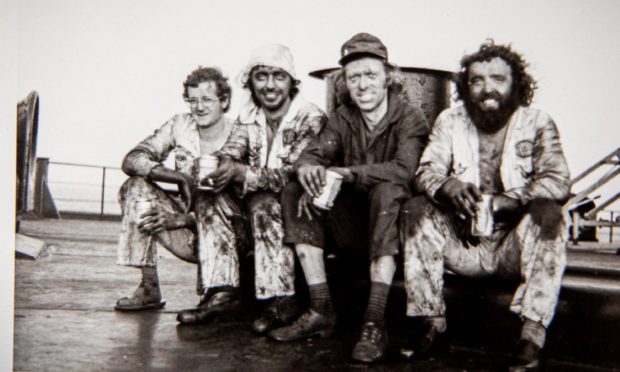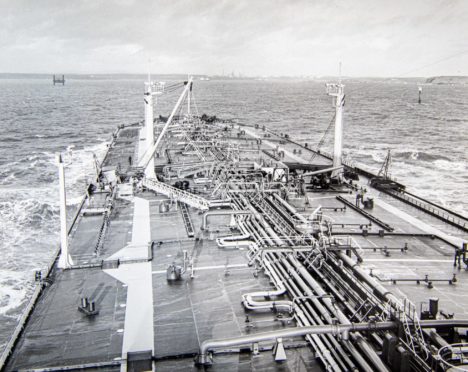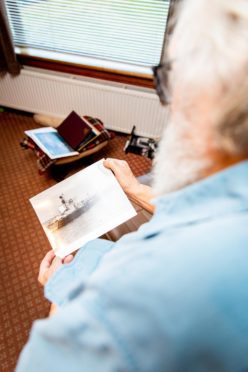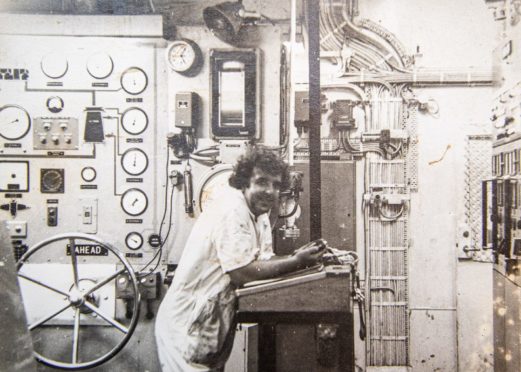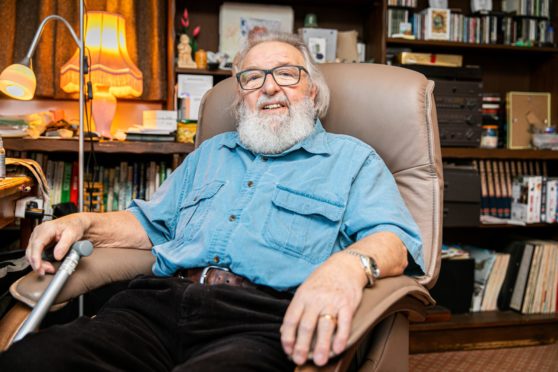It was the biggest super tanker in the world when it was launched almost half a century ago.
And even now, there is something imposing and impressive about the photographs of Esso Scotia, which was the size of three football pitches long and another one wide, and took about 13 minutes to bring to a halt once it was moving at sea.
Les Coxon doesn’t need to rely on old images to rekindle his fascination with these vessels.
Because he was one of two Dundee men who was among the crew when it caught fire during a journey from Singapore to Ras Tanura in the Gulf of Arabia in 1974.
This was another time and another place from the modern world of stringent health and safety regulations.
Les, who is now 79, was First Officer of Engines, when some lubricating oil dripped on to a pressure gauge, causing a pipe to blow out, after which the black substance spilled over a turbine and a fire started immediately.
It was 2.15 in the morning and the alarm sounded, even as he and his colleagues started responding to the emergency situation, while dressed just in boiler suits and as their hair grew hot and covered in black streaks.
The forgotten diamond engagement ring
But these were fearless characters, redoubtable individuals who knew they were sitting on a giant tinder box.
Tough-as-teak people who could find humour in any scenario.
The skipper on board, Bob Batchelor, another Dundonian, who later became the port master at Sullem Voe in Shetland, was among those who assembled the crew on the muster desk, as they checked that everybody was safe.
But, in the midst of the tumult and confusion, his wife, Margaret, rushed up to Les and asked: “Can I go back to my compartment?”
“Why?”
“Because I’ve forgotten to bring my diamond engagement ring.”
At which point, Les replied: “Oh, for heaven’s sake, when we get out of this, I’m sure that Bob will be happy to buy you another one.”
As the emergency situation developed in intensity, the crew relied on their skills and ingenuity and ability to think outside the box to tackle the blaze.
They were well aware that nobody was coming to rescue them; they and they alone could extinguish the flames or suffer the consequences.
And so these doughty colleagues knuckled down to their task with a steely resilience.
Bob was on the bridge in his pyjamas
Les recalled: “When the alarm sounded, I was in my room, but your coverall and shoes and socks were always on the back of the door of your cabin, and I got into them.
“But when I opened the door, the corridor was filled with thick black smoke – it was never pleasant when you smelt that in your throat – and I tried to crawl to the poop deck. It wasn’t easy to see what was ahead of me, but when I reached the scene, I’ll never forget Bob standing on the bridge in his pyjamas.
“I had to lead the fire party and we dragged the hoses in to the steering flat. The auto doors had shut, so we fitted our breathing apparatus and advanced forward.
”When you are fighting fire, you have to push the smoke in front of you, but we were struggling and we had to crawl to the top of the stairs and then go back in again.
“It’s funny the things you remember in these circumstances. One of the mechanics suffered from asthma and he needed a puffer (inhaler), but you can imagine how much use that was. One of my colleagues, a big Liverpudlian, broke the tension with a joke and I nearly fell off the ladder laughing at it.
“By this stage, the alarms were going full pelt, and when we went into the control room, we were running out of air. We had no more air bottles and the flames had melted the water spray system, while oil was burning in top of the bilges.
We were all covered in oily smoke
“We just had to persevere and deal with whatever problems arose. It wasn’t quite a case of put out the fire or face death – we had lifeboats on Esso Scotia which we could have used if everything else had failed – but we were nowhere near land and none of us fancied the idea of leaving the ship and trying to look for terra firma.
“Gradually, as we kept working, we started to get the upper hand. But it was tough. You didn’t stand on ceremony in these circumstances. Everybody did their best for one another. It was our job and we just had to get on with it.
“Time passed, hours went by, but you didn’t really think about things like that. There were 28 or 29 of us on board, so we couldn’t rely on a squad of others to bale us out. By the time morning arrived, we were absolutely covered in oily smoke – it was everywhere – and we needed a wash and something to eat and drink.
“But we were young, we could keep going, and eventually we cooled down the site and turned to the task of getting the power switched back on the ship.
“Allan Pengelly was the chief engineer and he did an excellent job in getting us going again, although it was by hand and not automatic. The whole thing took maybe five or six hours and we had been through the wringer, but there was no panic or hysteria.
“On the contrary, I seem to remember Margaret being more concerned about the fact that Bob had been in his pyjamas than anything else.
A trip full of Eastern promise
“My own wife, Margaret joined the ship for her holiday 10 days later when we passed Dubai and we were still doing repairs and running the ship by hand. But she wasn’t going out on a trip like that and we were together for the next six weeks.”
Les has myriad tales of his far-travelled life, whether in the Merchant Navy, or on Esso Scotia or Esso Warwickshire, or after he started working in the North Sea in the 1980s.
And he recalled how one of his chief officers, George Daiken was married to the model who appeared in a famous TV advert for Fry’s Turkish Delight – emerging from an unrolled carpet alongside the immortal words “Full of eastern promise”.
Mercifully, although he later worked on the rigs – “I was pretty old compared to the other lads on the platform” – Les was nowhere near Piper Alpha when the installation was involved in a devastating disaster on July 6 1988.
But he did endure another fraught incident the following year when he was nearly involved in a potential “blow-out” on the Treasure Saga installation, which led to him and more than 70 fellow workers being evacuated from the rig.
Les had his own Treasure Saga story
It was a situation which required environmental protection vessels, specially equipped to deal with oil spills, being placed on standby in the area, while Danish and British authorities were kept appraised of developments, but the leak was plugged, the danger averted and Les was sanguine about another turbulent chapter in his existence.
He said: “We were very fortunate, and I know life has been very good to me, but I was nearly 50 by the time I was on Treasure Saga and I realised it was time for a change.
“The rig was eventually brought by Transocean a few years later and it was rechristened Transocean Winner. Well, that was the same installation which ran aground on the Isle of Lewis in the Outer Hebrides (in 2016) and I remember watching it on TV.
”It brought back a lot of memories from those days when I was working out there.”
Les Coxon is one of those individuals who has a wealth of stories and is happy to chew the fat with anybody who might be interested. In fact, he probably has a good book in him if he decides to put his life into print.
As he concluded: “We arrived at the right time in the shipping world. There were all these people who had fought in the Second World War and they wanted to put something back and a lot of them were wonderful characters. You didn’t need qualifications if you had a desire to learn and the commitment to go places.
“Bob Batchelor was a good friend who died too soon (of cancer), but I will never forget being with him on the Esso Scotia and us travelling all over the world.”
